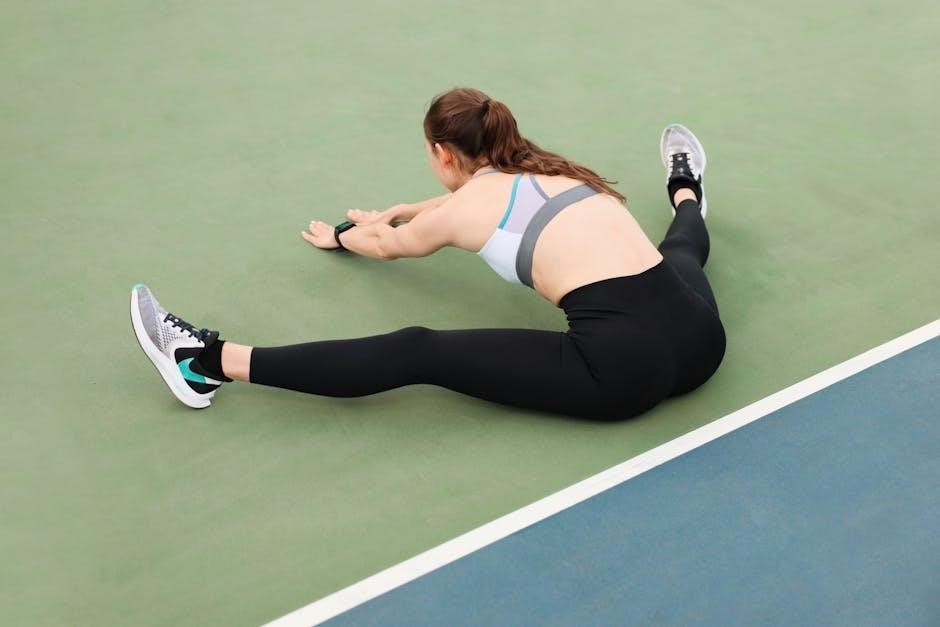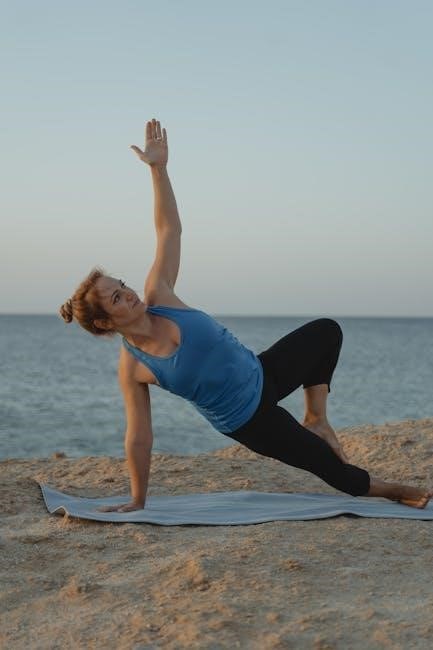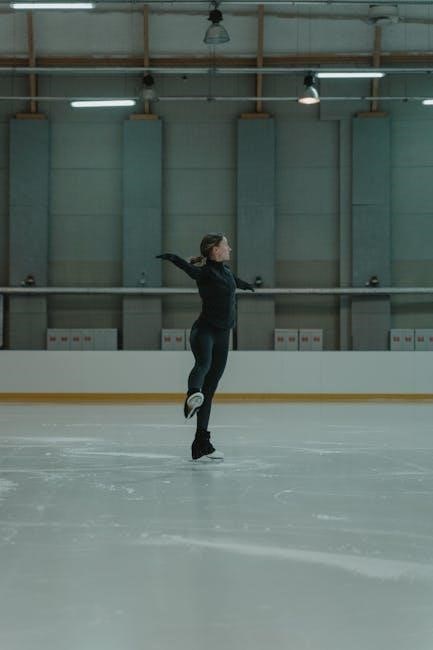Pes Anserine Bursitis is an inflammatory condition affecting the bursa near the knee‚ causing pain and stiffness. Exercises play a crucial role in managing symptoms and aiding recovery effectively.
Understanding Pes Anserine Bursitis
Pes Anserine Bursitis is an inflammatory condition affecting the bursa located beneath the hamstring tendons near the inner knee. This bursa‚ known as the Pes Anserine bursa‚ cushions the tendons of the semitendinosus‚ gracilis‚ and sartorius muscles as they move over the medial tibia. Inflammation occurs due to factors like repetitive motion‚ overuse‚ or direct trauma‚ leading to pain and stiffness in the inner knee area.
The condition often results from activities involving repetitive knee flexion‚ such as running or cycling‚ which can irritate the bursa. Contributing factors may include tight hamstrings‚ poor alignment‚ or obesity‚ which increases pressure on the bursa. Symptoms include localized pain‚ swelling‚ and reduced mobility. Diagnosis typically involves physical examination and imaging studies like ultrasound or MRI to confirm bursal inflammation.
Management strategies often begin with conservative approaches‚ including rest‚ ice therapy‚ and anti-inflammatory medications. Physical therapy plays a crucial role‚ incorporating exercises to stretch hamstrings and strengthen surrounding muscles‚ thereby reducing tendon tension and preventing recurrence. Avoiding aggravating activities during recovery is essential for healing and restoring knee function effectively.
Importance of Exercise in Managing the Condition
Exercise is a cornerstone in managing Pes Anserine Bursitis‚ as it helps reduce pain‚ improve mobility‚ and strengthen surrounding muscles. Gentle stretching exercises‚ such as hamstring and quadriceps stretches‚ can alleviate tension on the affected bursa. Strengthening exercises targeting the hamstrings‚ hip abductors‚ and core muscles help stabilize the knee and reduce repetitive strain. Low-impact activities like cycling or swimming are ideal for maintaining joint mobility without aggravating symptoms. Consistency in an exercise program prevents recurrence and restores functional movement. It is essential to perform exercises under professional guidance to ensure proper technique and progression‚ avoiding overexertion. A structured exercise plan tailored to individual needs supports long-term recovery and enhances overall knee health.

Symptoms and Diagnosis
Pes Anserine Bursitis often presents with pain on the inner knee‚ swelling‚ and tenderness. Diagnosis involves physical examination‚ patient history‚ and imaging like X-rays or MRI to confirm bursa inflammation.
Common Symptoms of Pes Anserine Bursitis
Pes Anserine Bursitis typically presents with pain on the inner side of the knee‚ often worsening with activities like running‚ cycling‚ or climbing stairs. Swelling and tenderness near the affected bursa are common‚ and patients may experience stiffness‚ especially after prolonged sitting. Pain may radiate along the inner thigh or shin‚ and kneeling or direct pressure on the area can exacerbate discomfort. Mild to moderate inflammation is usual‚ and in severe cases‚ limited knee mobility may occur. These symptoms often develop gradually‚ making early diagnosis and intervention crucial for effective management.
How to Diagnose Pes Anserine Bursitis
Diagnosing Pes Anserine Bursitis involves a combination of physical examination‚ patient history‚ and imaging. A healthcare provider typically performs a thorough evaluation‚ palpating the inner knee to identify tenderness and swelling near the pes anserine bursa. Pain during activities like squatting or climbing stairs may be noted. Imaging‚ such as X-rays or MRIs‚ can confirm the diagnosis by ruling out other conditions like fractures or meniscal tears. A physical therapist may assess range of motion and strength to identify limitations. In some cases‚ ultrasound may be used to visualize inflammation. Accurate diagnosis is essential to differentiate Pes Anserine Bursitis from other knee conditions‚ ensuring appropriate treatment.

Treatment Options
Treatment for Pes Anserine Bursitis often includes rest‚ ice‚ anti-inflammatory medications‚ and physical therapy. Bracing and corticosteroid injections may be recommended for severe cases.
Conservative Treatment Approaches
Conservative treatment for Pes Anserine Bursitis focuses on reducing inflammation and pain through non-invasive methods. Rest‚ ice‚ compression‚ and elevation (RICE) are commonly recommended to alleviate symptoms. Physical therapy plays a central role‚ emphasizing stretching and strengthening exercises to improve knee function and reduce strain on the affected bursa. Anti-inflammatory medications‚ such as NSAIDs‚ may be prescribed to manage pain and swelling. In some cases‚ bracing or taping can provide additional support to the knee. A gradual return to activity is encouraged‚ with a focus on low-impact exercises to prevent further irritation. These approaches aim to restore mobility and strength while minimizing discomfort.
Role of Physical Therapy in Recovery
Physical therapy is essential for recovery from Pes Anserine Bursitis‚ focusing on reducing inflammation‚ improving mobility‚ and strengthening surrounding muscles. A structured exercise program‚ guided by a physical therapist‚ includes stretching exercises like hamstring and hip flexor stretches to enhance flexibility. Strengthening exercises‚ such as quadriceps sets and leg lifts‚ help stabilize the knee joint and reduce strain on the bursa. Low-impact activities‚ like swimming or cycling‚ are encouraged to maintain fitness without aggravating the condition. Pain management during exercises is crucial‚ with a focus on avoiding activities that cause discomfort beyond a 4/10 pain level. Regular physical therapy sessions ensure proper progression and prevent future flare-ups‚ promoting long-term recovery and functional improvement.

Exercise Program for Pes Anserine Bursitis
A comprehensive exercise program includes stretching‚ strengthening‚ and endurance exercises to reduce inflammation and improve knee function. Start slowly‚ avoiding pain beyond 4/10‚ and progress gradually. A PDF guide provides detailed instructions and illustrations for each exercise‚ ensuring a structured approach to recovery.
Stretching Exercises
Stretching exercises are essential for managing Pes Anserine Bursitis‚ focusing on the hamstrings‚ quadriceps‚ and hip adductors. Begin with gentle stretches like the hamstring stretch‚ where you lie on your back with your leg bent and extend it toward the ceiling. Standing calf stretches and quadriceps stretches can also alleviate tightness. Incorporate the hip adductor stretch by placing your foot on a low step and gently stretching the inner thigh. These exercises should be performed daily‚ holding each stretch for 20-30 seconds to improve flexibility. Avoid bouncing or forcing the stretch beyond a comfortable range. Progress gradually to prevent exacerbating the condition. A PDF guide provides visuals and step-by-step instructions for proper form and technique.
Strengthening Exercises
Strengthening exercises are vital for recovering from Pes Anserine Bursitis‚ focusing on the quadriceps‚ hamstrings‚ and hip muscles. Begin with quad sets by tightening the thigh muscles and holding for 5 seconds. Straight leg raises are also effective‚ lifting the leg without bending the knee. Progress to hip bridges by lifting the hips while maintaining a neutral spine. Strengthening the core and glutes through exercises like side-lying leg lifts can improve stability. Perform these exercises 2-3 times daily‚ starting with 3 sets of 10 repetitions and gradually increasing as strength improves. Avoid any movement that causes sharp pain‚ ensuring exercises are done with controlled‚ smooth motions. A PDF guide offers detailed instructions and visuals to ensure proper form and progression.
Endurance and Flexibility Exercises
Endurance and flexibility exercises are essential for managing Pes Anserine Bursitis‚ improving range of motion‚ and reducing stiffness. Start with standing calf stretches to enhance ankle and calf flexibility. Seated hamstring stretches can help alleviate tightness in the back of the thigh. Straight leg raises‚ performed while lying down‚ strengthen the quadriceps without straining the knee. For endurance‚ incorporate low-impact activities like swimming or cycling to maintain cardiovascular fitness without exacerbating inflammation. Hold each stretch for 20-30 seconds and repeat 2-3 times daily. Avoid bouncing during stretches to prevent further irritation. A PDF guide provides detailed routines and progression plans to ensure safe and effective practice‚ promoting long-term flexibility and endurance.

Exercises to Avoid
Avoid high-impact activities‚ deep knee bends‚ and exercises causing sharp pain or discomfort. These can worsen Pes Anserine Bursitis and delay recovery. Opt for low-impact alternatives instead.
Activities That May Worsen the Condition
Certain activities can exacerbate Pes Anserine Bursitis‚ such as high-impact exercises like running‚ jumping‚ or repetitive knee bending. Deep squats‚ lunges‚ and twisting motions may also aggravate the condition. Avoiding prolonged sitting or standing‚ especially on hard surfaces‚ is recommended. Repetitive movements that involve knee flexion‚ like cycling with high resistance‚ can also worsen symptoms. It’s important to identify and avoid any activity that causes sharp pain or discomfort‚ as this can lead to further inflammation and delay recovery. Consulting with a healthcare professional or physical therapist can help determine which activities are safe and which should be avoided during the healing process.
Modifying Exercises for Safe Practice
Modifying exercises is essential to safely manage Pes Anserine Bursitis. Avoid high-impact activities and opt for low-impact alternatives like swimming or cycling with low resistance. Reduce the depth of squats and lunges to avoid knee stress. Replace running with brisk walking or elliptical training. Strengthening exercises should focus on controlled movements‚ such as straight-leg raises or wall-assisted bridges‚ avoiding heavy weights. Stretching should be gentle‚ with a focus on hamstrings‚ quadriceps‚ and hip flexors; Use supportive gear like knee braces or orthotics if needed. Prioritize pain-free ranges of motion and gradually increase intensity. Always warm up before exercises and cool down afterward. A tailored approach ensures exercises are effective while minimizing the risk of worsening symptoms.

PDF Guide for Pes Anserine Bursitis Exercises
Download a comprehensive PDF guide with detailed exercises‚ instructions‚ and tips for managing Pes Anserine Bursitis. Includes stretching‚ strengthening‚ and endurance routines with clear illustrations and timelines for safe practice and recovery.

What to Expect in the PDF Guide
The PDF guide provides a comprehensive program for managing Pes Anserine Bursitis‚ including detailed stretching‚ strengthening‚ and endurance exercises. It outlines a structured timeline for recovery‚ with clear instructions and illustrations to ensure safe practice. The guide also covers essential tips for modifying exercises based on individual progress and pain levels. Additionally‚ it includes information on proper warm-up routines‚ cool-down stretches‚ and nutritional advice to support healing. The exercises are categorized by difficulty‚ allowing users to gradually progress from basic to advanced movements. This resource is designed to empower individuals to take an active role in their rehabilitation‚ promoting long-term relief and preventing future flare-ups.

Downloading and Using the Exercise Guide

The Pes Anserine Bursitis Exercise Guide is easily downloadable as a PDF from reputable sources‚ offering a structured program for rehabilitation. The guide provides clear instructions‚ visuals‚ and timelines for exercises tailored to different stages of recovery. Users can expect a 4-week plan with daily routines‚ ensuring gradual progress. It emphasizes safety‚ advising to stop exercises if pain exceeds a moderate level. The guide is customizable‚ allowing individuals to adjust based on their comfort and progress. By following the outlined program‚ users can effectively manage symptoms‚ improve flexibility‚ and strengthen the affected area. Consistency is key‚ and the guide serves as a handy reference for home-based rehabilitation.

Rehabilitation and Progression
A structured exercise program aids in gradual recovery‚ starting with gentle stretches and progressing to strengthening and flexibility exercises. Avoiding overexertion ensures optimal healing and long-term relief.
Home Exercise Program
A home exercise program for pes anserine bursitis focuses on reducing pain and improving knee function through stretching‚ strengthening‚ and flexibility exercises. Gentle stretches‚ such as hamstring and quadriceps stretches‚ are often recommended to alleviate tightness and discomfort. Strengthening exercises‚ like straight leg raises and wall sits‚ help build muscle support around the knee. It’s important to perform these exercises 2-3 times daily‚ as prescribed‚ to promote healing and prevent recurrence. Progress slowly‚ avoiding pain beyond a 4/10 intensity. Consistency is key to achieving long-term relief and restoring normal knee mobility. Always consult a healthcare provider before starting any new exercise routine.
Timeline for Exercise Progression
A structured timeline for exercise progression in pes anserine bursitis typically spans 4-6 weeks‚ focusing on gradual recovery. Weeks 1-2 emphasize gentle stretching‚ such as hamstring and hip flexor stretches‚ to reduce stiffness. Strengthening exercises‚ like straight leg raises and mini squats‚ are introduced in weeks 3-4 to improve muscle support. Pain should guide progression‚ with activities adjusted to avoid exceeding a 4/10 pain level. By week 5-6‚ endurance exercises like cycling or swimming can be added to enhance flexibility and strength. Consistency is key‚ with exercises performed 2-3 times daily. Progression should always be supervised by a healthcare provider to ensure proper healing and prevent recurrence;
Effective management of Pes Anserine Bursitis involves targeted exercises‚ proper recovery‚ and a comprehensive approach to restore knee function and reduce inflammation‚ as detailed in the PDF guide.
Effective Management Through Exercise
Exercise is a cornerstone in managing Pes Anserine Bursitis‚ focusing on reducing inflammation‚ improving flexibility‚ and strengthening surrounding muscles. Gentle stretches‚ such as hamstring and quadriceps exercises‚ help alleviate tension. Strengthening activities like leg raises and bridges enhance muscle support around the knee. Low-impact endurance exercises‚ including cycling or swimming‚ promote joint mobility without aggravating the condition. Consistency is key‚ with exercises performed daily as tolerated. Pain should not exceed a moderate level during workouts. A structured exercise program‚ as outlined in the PDF guide‚ ensures a progressive and safe approach to recovery‚ helping individuals regain functional mobility and reduce long-term discomfort effectively.